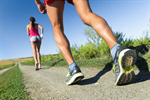

Q1
What are moulded orthotics?
Moulded Orthotics are made to measure foot supports made from plaster moulds or 3 dimensional scans of feet.
They give an exact fit and provide degrees of correction and amounts of support to keep the body in straight alignment.
They are used widely for walking and in sports and running to provide shock absorption.
Q2
What materials are moulded orthotics made from?
In the past many moulded orthotics were made from hard materials such as carbon fibre and fibre glass.
Recently more specialist shock absorbing materials are commonly used to reduce shock and give cushioning in walking especially sporting activities and running.
The materials used are shock absorbing light and easy to clean. They are used for sports and used widely for walking.
Q3
Is it best to have a plaster bandage cast or a 3D scan impression to make moulded orthotics?
There is no research at present to suggest scanning is more accurate than plaster bandage casting
I use both three dimensional digitised scanning and plaster bandage casting depending on differing conditions and height of support required.
Digitised casting is the only repeatable method of taking three dimensional impressions of a foot.
Q4
What can moulded orthotics do for me?
The main function of moulded orthotics is to correct body alignment or increase shock absorption.
Therefore to help in ankle, knee hip and lower back pains especially if the feet roll in during walking and running.
Q5
Why should I have moulded orthotics?
For many people moulded orthotics are invaluable in reducing shock and maintaining straight walking and running.
This improves body posture and helps higher joints in the knees, hips and in the back.
Q6
Are made-to-measure moulded orthotics better than off the shelf orthotics?

Bespoke orthotics are moulded around the exact contours of each foot. The highest forces of shock which go up the body are as the heel strikes down.
Therefore they fit accurately around each heel and when using a shock absorbing material moulded around the contour of the heel, this increases the surface area and reduces the impact of the ground forces.
Over days and weeks of wearing the bespoke orthotics there will be significantly less shock transferred up into the body, to the ankles, knees, hips, lower and upper back when walking or running.
Q7
What is the basis of pricing moulded orthotics?
Making accurate moulded orthotics takes time and is skilled work. Plaster bandage is placed around the foot and the ankle whilst the plaster sets can be recorded by a patented system electronically. Or a three dimensional scan may be taken. A positive mould is then made, normally out of plaster or resin.
The chosen material for the orthotic is then heated inside an oven and pressed over the mould of each foot under pressure separately. As the material cools it retains the memory of the shape of each foot mould exactly. Next the height of the orthotic is ground.
Finally the accurate angle of the orthotic is ground using calibrated horizontal belt grinders. These are calibrated to single level degree accuracy. The angle of the orthotics is of the utmost importance. A single degree incorrect at foot level can lead to swaying and leaning at higher back or shoulder levels.
Q8
What conditions are moulded orthotics used for?

Moulded orthotics can be used in the treatment of all of the following.
Hips:
If the feet inroll or pronate this has the effect of increasing internal rotation of the whole leg and therefore greater pressure is placed on the hip joints during each step and also when standing still.
Shock absorbing materials are used for hips to reduce shock and also to provide the correct support under the foot arches to correct the alignment. Podiatrists make many moulded orthotics where hip pain is present for use in walking ,sports and for running.
Knees:
Moulded Orthotics are very effective for preventing, reducing and eliminating knee pains. They work by reducing shock and maintaining straight alignment. If the feet inroll or the alignment of the legs
is not straight then greater forces go through the knee joints producing pains on standing and when walking or running. Orthotics can correct alignment and eliminate symptoms.

Back Pain:
Moulded Orthotics are effective in eliminating or reducing lower back pain. They work by reducing the impact forces as the heel strikes down,reducing the shock going up the body. I use the best shock
absorbing materials to reduce the shock in walking and running. Orthotics also stabilise the pelvis especially if one foot rolls in more than another.
Ankles:
Moulded Orthotics are very effective in giving stability to ankles where the ankle joint is weakened or has twisted. Particularly when the lateral (outer) ligaments are weakened. By moulding an orthotic
with a high outer border, the orthotic provides additional support for the ligaments to prevent subsequent twists of the ankle. Moulded orthotics fit exactly and prevent the rolling out and twisting. Many sports
people who have had ankle twists wear orthotics especially football, rugby players and racket sports players.
Achilles Tendonitis:
Moulded orthotics are used widely for Achilles tendonitis. The orthotics by stabilising any excess movement of the foot to roll in reduce sideways movements to the Achilles tendon. The orthotics material
reduces jarring to the tendon and a small raise can be incorporated into the orthotic to reduce the pulling on the tendon from the calf muscle.

Heel Pain:
Moulded Orthotics are used for eliminating heel pain. If the heels are painful the inflamed area (often the plantar fascia) has pressure placed upon it every day. When a shock absorbing soft material is
moulded around the exact shape of the heel ( increasing the surface area ) the tissue within the heel has less pressure and less shock placed upon it. Moulded orthotics are therefore widely used for heel pain
and preventing episodes of heel pain reoccurring.They are also very effective at settling even long standing resistant plantar fasciitis.
Arch Pain:
Moulded Orthotics provide exact and equal support to the whole of the arch. A moulded orthotic will give the correct amount of support individually to each foot and are used to relieve and remove arch
pain. Each contour of each arch is supported in a moulded orthotic and the moulds capture the differences in each foot, such as if one foot rolls in further than another. This is a major difference above off
the shelf supports as many people have feet which roll in differing amounts, many of the preformed orthotics are inaccurate in one or both of the orthotics.
Flat Feet and low arches:
Moulded orthotics are used widely for flat feet and low arches and provide the correct amount of support to prevent the arch from further falling. They provide the correct amount of support to each contour
of each arch whilst being comfortable and supportive. Once the moulds are taken I store the positive moulds in racks at maintained temperatures so that further pairs can be pressed over them in the future.
Forefoot Pain:
Moulded orthotics are used to eliminate forefoot pains. They are used to redistribute pressure away from high pressure painful areas (such as bruising, neuromas, corns and calloused areas) and will capture
the exact contour of each forefoot. The best cushioning materials are vacuum pressed against the forefoot areas to give excellent comfortable cushioning.
Q9
Do you offer a service which covers private medical insurance?
Yes, Andrew Root podiatrist is covered for some private medical insurance policies. Many private schemes more recently do not cover for podiatrists orthotics. Some cover for the biomechanical assessment.
Ask me at the first appointment or call to ask your insurance provider.